Canon EOS 5D Mark II Image Quality
The Canon EOS 5D Mark II image quality kicks ass. This camera produces beautiful, detailed images with subtle tonal blends and great color. There may be cameras with better image quality, but who cares? The majority of us will never need anything better than this. I was able to take pictures with the 5D Mk II that I had only dreamed of before. The key to the 5D Mark II’s image quality is the full-frame sensor and the larger pixels it allows. Bigger pixels collect more photons and that means less noise, better color, and sharper photos. Fourteen-bit analog to digital conversion delivers a wider range of colors and tones for smoother tonal blends and more post-processing potential – you can push the 5D Mk II files really hard in post-processing if you need to. There’s lots of detail to be had from shadows, even if you can’t see it when you open the files on the computer. Highlight Tone Priority mode means wedding photographers will be able to hold detail in the dress and in-camera Peripheral Illumination Correction helps even exposure across image and correct for vignetting.
The 22-megapixel resolution means whatever noise the camera does produce is effectively minimized. This is something pixel-peepers don’t see viewing images at 100% on the computer – you have to make prints to really see it. If you shoot the same subject with the 21-megapixel 5D Mark II and a 10-megapixel camera and then make prints from both, each bit of “grain” in the 5D Mark II print will be half the size of grain from the lower-resolution camera. Lower noise plus higher resolution equals awesome print quality. To test this I made 8.5×11 prints from ISO 800 and ISO 3200 images. The ISO 800 print is smooth and grain-free with great detail and color. It looks like what I’ve learned to expect from ISO 100 images. The ISO 3200 print has a little visible noise but it’s not at all offensive. There’s also a surprising amount of fine detail for a photo shot at high ISO – especially this high. There was a time when I tried to never shoot above ISO 200. With the 5D Mk II I think ISO 1600 is a reasonable limit with ISO 3200 being a totally usable backup. You can make 16×20 inch prints with no interpolation from the 5616 x 3744 pixel files. And with proper handling the sky’s the limit as far as print size goes.
 |
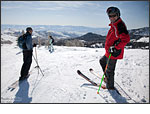 |
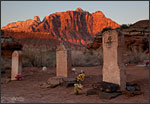 |
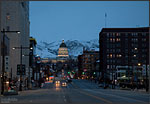 |
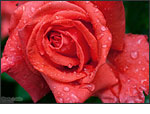 |
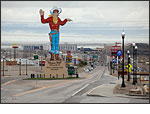 |
Click on thumbnails to view sample photos.
next page – Canon EOS 5D Mark II Conclusion >>
|


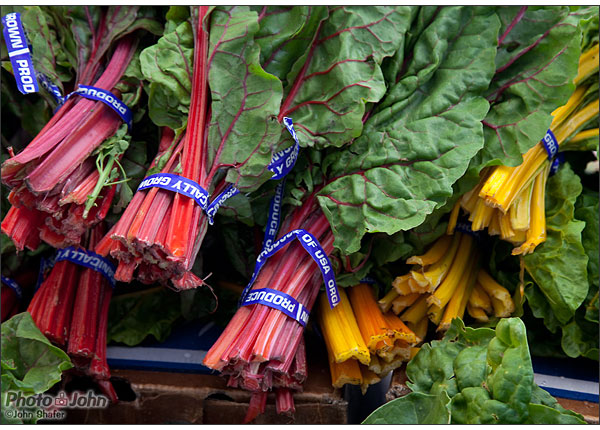

A few remarks about your review. You say it is possible to shoot in the dark with the Mark II and a 24-105 f4 at ISO 3200. That may be true but people should consider that f4 is three stops slower than 1.4 wich means you can shoot using the same shutter speed at ISO 400. You can do that with any camera.
And it depends on your subjects of course but flash (or extra lights) will always be needed. Maybe not to light the whole picture but certainly to change the light balance within the picture.
Finally, you may think it is heavy but it is actually 20% lighter than the D700. So you can also say it is relatively light.
Amedi-
Thanks for commenting. Very true that the 5D Mk II is lighter than some other pro cameras. That’s a good perspective to add. It’s definitely lighter than the Canon EOS-1D cameras. Personally, I am always trying to go as light as possible when I’m in the backcountry. And that’s why I said the 5D Mk II is heavy. It’s also a much coveted camera for people just starting to work as pro photographers. And some of those people will be surprised at the weight. But if you’re workiing in the studio or on the street the weight shouldn’t be an issue. It’s only an issue for me when I’m on my mountain bike.
Regarding “shooting in the dark” – I may have been a little overexuberant there
It’s true that a faster lens will always offer better image quality because it collects more light. But the flexibility of the 24-10f f/4L zoom is really, really nice. You can do almost anything with it. And the high ISO performance of the 5D Mk II is so good that I don’t think it’s a big deal to shoot at ISO 800 or even 1600. So you’re absolutely right about faster lenses. You’ll get better image quality if you use an f/1.4 prime. But it’s not going to be nearly as versatile as the 24-105mm f/4L or another reasonably fast zoom.
Amedi – shooting with f1.4 – good luck! Depth of field is limited to the extend of sharp eyes/blurry nose or the opposite, if shooting a portrait, and forget about group of people. Unless you really need a very special – featured picture, I can’t imagine using 1.4 for practical purposes.
Photo-John – sorry, faster lens does not offer a better image quality, it’s always much softer at the wide end (maximum aperture), but what it can do is to allow faster autofocus, brighter viewfinder and sometimes can “save the day” in a really dark environment, at the price of shallow depth of field, unless this is an intended effect. 1.4 prime and 24-105 have very similar image quality at 5.6 and higher (resolution wise). I do have some primes, but unless I need it for really close micro, zooms are much more practical…
Canon just announced the EOS 7D, an APS-C brother to the EOS 5D Mk II. Note that I didn’t say “little” brother. That’s because the EOS 7D offers a lot of benefits over the 5D Mk II, including faster frame rate, better AF and more video options. Learn more in our preview article:
Canon EOS 7D Digital SLR Preview >>
Shooting at 1.4 is seldom practical, unless you a quite a distance from the subject. Forget about shooting this wide for any wide subject capturing needs. The 24-105L is an exceptional lens, no question. Coupled with the 5DMarkII’s excellent ISO performance, you have an excellent general purpose combination.
The assertion that 2.8 glass yields better image quality is fundamentally untrue. Wider glass is faster, and capable of gathering more light, but this often comes at the penalty agianst image quality. It is the higher class zooms(L glass) and primes that are engineered better to deal with the inherent challenges of wide aperture glass. There are plenty of vendors that offer 2.8 glass that is clearly inferior to Canon L 2.8 glass.
The Canon 7D is excellent, but comes up short in comparison to the 5D MarkII where it is most important; Image quality and high iso performance. So it just depends on what features are most important to you. I own a 17-40 f4L, and would want to give up my true wide focal length for the sake of a much smaller 1.6 crop. But that’s just me.
I have an eos 5d mk 1 and have decided to wait for a 5d mk3 before I upgrade, due to the dated 9 point focus layout of the 5d mk11. To get my tech fix, I have purchased the eos 7d as my second camera which should keep me going in the meantime. Canon – please upgrade the old 9 point focus system on the 5d mk2 and I’ll buy one at once… honest!
http://www.jackcutting.com